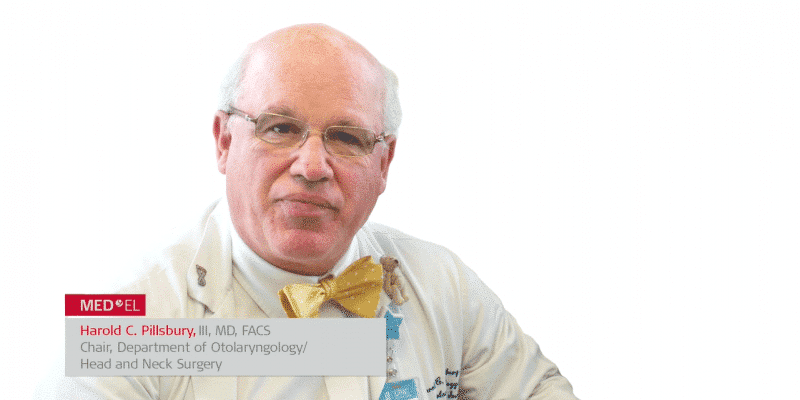Cochlear Implant Surgical Case Study: Dr. Harold Pillsbury

The MED-EL Surgical Video Library offers complete surgical case studies from leading ENT surgeons. Created in cooperation with ARRI, these high-resolution videos capture precise movements and detailed structures with incredible clarity. Access is free and the easy-to-use library is optimized for desktop or mobile viewing.
In today’s HD surgical case study, Dr. Harold Pillsbury guides us through his technique with the MED-EL CONCERT cochlear implant. Dr. Pillsbury is the Chair of the Department of Otolaryngology/Head and Neck Surgery at University of Carolina School of Medicine.
Cochlear Implant Surgical Case Study
This patient is a 64-year-old woman with progressive bilateral hearing loss, and this is her second cochlear implant. The pre-operative audiogram shows minimal-to-no residual hearing. Despite multiple comorbidities, (hypertension, heart attack, Crohn’s disease), there are no complications in this case.
Dr. Pillsbury narrates the surgical video and provides valuable insight into his surgical techniques. He also explains why you cannot use monopolar cautery on a patient with a cochlear implant. In this case, the patient received a MED-EL CONCERT implant with a 31.5 mm Standard electrode array. However, these techniques are also applicable for SYNCHRONY.
One-month post-operative audiogram shows excellent results, with HINT scores going from 0% to 92% for the implanted ear.
- Adult female, 64 years, left ear
- Multiple comorbidities
- Profound bilateral sensorineural hearing loss
- Sequential bilateral implantation
- MED-EL CONCERT Implant
- 5 mm Standard array
- RONDO Single-Unit Processor
Watch now: Dr. Harold Pillsbury guides us through his technique for implanting a MED-EL cochlear implant with 31.5 mm Standard electrode array (15 min).
What to watch for:
- Preoperative CT & audiogram
- Layered post-auricular incision
- Marking of the mastoid for visibility
- Drilling the mastoidectomy
- Exposing the antrum
- Locating the facial nerve and chorda tympani
- Marking implant placement
- Drilling implant bed
- Creating electrode lead channel
- Suturing implant with resorbable sutures
- Inserting electrode array into cochlea
- Wound closure in layer
- Intra-operative objective measures
- Post-operative imaging with full insertion
- Post-operative audiogram with speech perception scores
*Not all products, indications, and features shown are available in all areas. Please contact your local MED-EL representative for more information.
CTA Form Success Message
Send us a message
Field is required
John Doe
Field is required
name@mail.com
Field is required
What do you think?
The content on this website is for general informational purposes only and should not be taken as medical advice. Please contact your doctor or hearing specialist to learn what type of hearing solution is suitable for your specific needs. Not all products, features, or indications shown are approved in all countries.



